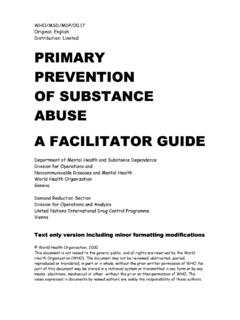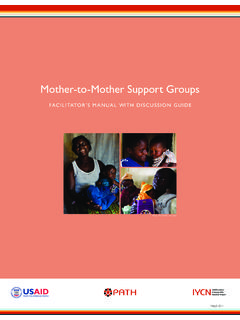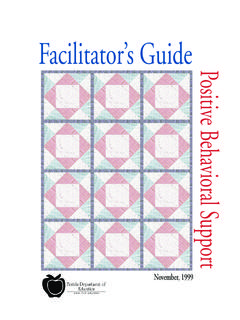Transcription of Visual Facilitator’s Guide
1 Visual facilitator 's Guide International Labour Organization The designations employed and the presentation of material in this information product do not imply the expression of any opinion whatsoever on the part of the Food and Agriculture Organization of the United Nations concerning the legal or development status of any country, territory, city or area or of its authorities, or concerning the delimitation of its frontiers or boundaries. The mention of brands or products, whether or not they are patented, does not mean that they have been approved or recommended by FAO or ILO, or that they have a preference for that product over others of a similar type. The opinions expressed in this material are those of the author (or authors) and do not necessarily reflect the views or policies of FAO or ILO.
2 FAO and ILO encourage the use, reproduction and dissemination of the information contained in this material. Unless indicated to the contrary, the material can be copied, downloaded and printed for purposes of private study, research and teaching, or for all other non-commercial uses. This is under the condition that FAO and ILO are recognised as the sources and co authors of the material and it is clearly established that the views, products, or services depicted are not in any event sanctioned by FAO or ILO. Any requests for the translation, adaption, and any other commercial use of this material must be made via the site or addressed to FAO and ILO 2015. Preventing and reducing children's exposure to pesticides Aim: Participants are enabled to reduce children's exposure to pesticides Objective: By the end of this module participants will be able to: zzIdentify how children are exposed to pesticides, including through work and chores zzDescribe the negative health effects of pesticides and why children are at a greater risk zzIdentify what they can do to reduce the exposure of children to pesticides in their community zzShare the information with others Sessions Session 1: How are children exposed to pesticides?
3 Session 2: What are the negative effects of pesticides on health and human development? Why are children at greater risk? Session 3: What can we do to reduce children's exposure to pesticides in our community? Depending on the needs of the participants, the sessions can be led in the order they appear in this book or in the sequence 2,1,3, focusing first on the symptoms and damaging effects of pesticide exposure and then on the sources of exposure and corresponding protection methods. Before beginning each training session, it is important to familiarize yourself with the illustrations and the corresponding text. PROTECT CHILDREN FROM PESTICIDES! Visual facilitator 's Guide Preliminary version Food and Agriculture Organization of the United Nations International Labour Organization Session 1: How are children exposed to pesticides?
4 Session objective The participants are able to identify where and how children are exposed to pesticides, in particular through work and chores. Instructions for the facilitator To facilitate the session, first Guide the farmers to think about the cycle of pesticide use: from its purchase through to its preparation, application and storage or disposal, and from the start to the end of the working day. Encourage participants to think about where these activities take place and where the various members of their families are at these times. With this in mind, ask participants: Where might children be exposed to pesticides? Potential answers include: On the farm, at home, in shops, through the food they eat, water they drink or the environment, on someone's back, in the womb.
5 Key messages to keep in mind Children may be exposed to pesticides several times during the course of a day and in different places. The more they are exposed, the more they are in danger. Child workers are at even greater risk of exposure to pesticides. 1. How are children exposed to pesticides? Session 1: How are children exposed to pesticides? Sale and purchase Encourage the participants to think about the different steps in the use of pesticides. It begins with the sale and purchase of the pesticide. zz Exposure occurs when products are spilled and during the loading, unloading, storing and displaying of pesticides. zz Children are exposed by ingesting products, through respiration, or when a pesticide comes into contact with the skin.
6 Continue the discussion asking the Key message: participants: Purchasing, selling and transporting pesticides How does children's involvement in domestic can be dangerous. work and work in the fields increase their risk Children must not of being exposed to pesticides? participate. 1. How are children exposed to pesticides? Preparation Children may be exposed during the preparation of pesticides, for example by mixing them. zz Handling concentrated pesticides can be extremely dangerous, especially for children. zz When mixing, the liquid can get splashed on the children's skin or in their eyes. zz Pesticides can get spilled on clothing and then come into contact with the skin. zz Children may breathe in particles or dust Key message: that comes from highly concentrated Preparing pesticides is dangerous.
7 Children must powders and granules used in the not be involved and must preparation of a pesticide. be kept at a distance during the preparation process. 1. How are children exposed to pesticides? Application Children are exposed when they spread pesticides by hand. 1. How are children exposed to pesticides? Application Children can be harmed by pesticides, even when applying pesticides using a backpack sprayer. Often, children have not received training on how to safely use this equipment, which greatly increases the risk of exposure. 1. How are children exposed to pesticides? Working in the fields Children who work in the fields are exposed when they work in places where pesticides have been applied. Touching the plants when Key message: weeding and doing other tasks Because children are smaller and or just breathing the air where their bodies have not yet fully pesticides were used exposes developed, they should wait longer than adults before returning to fields them to the dangers.
8 After pesticides have been used. 1. How are children exposed to pesticides? Cleaning Even after application, children can still be exposed to pesticides. For example, when cleaning containers or equipment used to apply pesticides (they can never be completely clean ). 1. How are children exposed to pesticides? Washing Even after application, children can still be exposed to pesticides. For example, through washing clothes that were worn: zz while pesticides were applied;. zz during the preparation of pesticides; or zz in the fields just after pesticides were used. 1. How are children exposed to pesticides? Reusing pesticide containers Children can also be exposed through the reuse of pesticide containers to transport food or Key message: water.
9 Reusing pesticide containers for food or drink is extremely dangerous to the health of those who eat or drink from them. 1. How are children exposed to pesticides? Reusing pesticide containers Children can also be exposed by reusing pesticide containers to collect or store food and water. Key message: Reusing pesticide containers to collect and store food and water is extremely dangerous. 1. How are children exposed to pesticides? Environment Children can be exposed through their environment; pesticides used on crops can enter into the underground water source. When it is then taken Key message: out of wells, it is hard to know if it is The use of dangerous pesticides can contaminate contaminated or not. the water source and make it undrinkable.
10 1. How are children exposed to pesticides? Environment Pesticides can be transported on the wind and be dangerous to those in the area: adults at work but also children working, playing or on their mother's back. Key message: Schools and play areas must not be close to Children must not be in fields when pesticides are used, and farmers or near the fields when should avoid using pesticides on windy days. pesticides are applied. 1. How are children exposed to pesticides? In the womb Children can be exposed to pesticides even before their birth when they are in the womb. They are also exposed through Key message: breastfeeding. Pregnant women and Extra precautions must be taken to nursing mothers should not be exposed to pesticides. ensure that pregnant women and nursing They and their children are mothers are not exposed to pesticides.

















